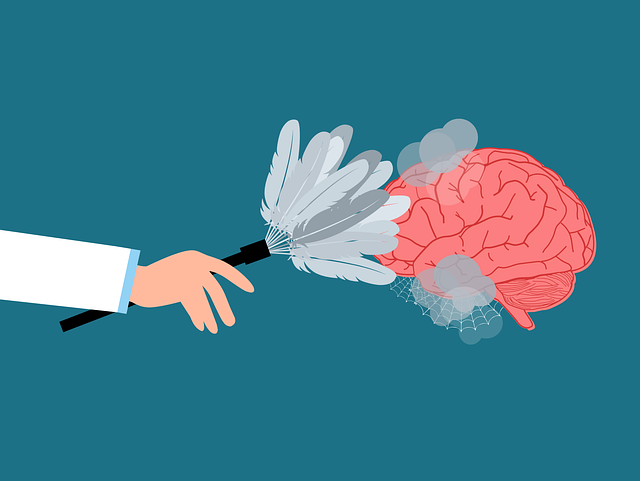Broomfield Gender Identity Therapy (BGIT) focuses on understanding community needs through engagement with local organizations, cultural sensitivity, and empathy-building strategies. They design inclusive outreach programs targeting diverse demographics, leveraging partnerships with LGBTQ+ centers and mental health advocacy groups to reach a wider audience. Key initiatives include healthcare provider training, awareness campaigns, community events, and policy advocacy. BGIT implements evidence-based practices, collects data on program impact, and adapts strategies for continuous improvement, ensuring relevant and effective support for individuals seeking trauma support services and enhancing overall well-being.
Broomfield Gender Identity Therapy (BGIT) has emerged as a vital community resource, offering specialized services through strategic outreach programs. This article explores the comprehensive implementation of BGIT initiatives, focusing on understanding diverse community needs and tailoring therapeutic support. We delve into designing effective outreach strategies, fostering partnerships with local entities, and ensuring logistical excellence. By examining impact measurement and adaptive practices, this guide highlights best practices for maximizing BGIT’s reach and positive influence within the Broomfield community.
- Understanding Community Needs: Identifying Target Groups for Broomfield Gender Identity Therapy Programs
- Designing Comprehensive Outreach Strategies: Effective Communication and Engagement Techniques
- Building Partnerships: Collaborating with Local Organizations and Community Leaders
- Implementing Program Logistics: Space, Resources, and Staffing Considerations for Success
- Measuring Impact and Adapting: Evaluating Outreach Efforts and Continuous Improvement for Broomfield Gender Identity Therapy
Understanding Community Needs: Identifying Target Groups for Broomfield Gender Identity Therapy Programs

Understanding Community Needs is a pivotal step in implementing successful Broomfield Gender Identity Therapy Programs. To effectively reach and support individuals, it’s essential to identify specific target groups within the community. This involves recognizing diverse gender identities, ages, socioeconomic backgrounds, and cultural affiliations. By conducting thorough research, engaging with local organizations, and listening to community feedback, Broomfield Gender Identity Therapy can pinpoint areas of greatest need.
Focusing on these identified groups ensures that therapy services are tailored to address unique challenges. For instance, young adults navigating gender transition might require support for academic and social transitions, while older individuals may face burnout prevention strategies specific to their life stage. Incorporating elements of emotional intelligence and cultural sensitivity in mental healthcare practice is also crucial. Understanding the interconnection between identity, mental health, and societal factors empowers therapists to provide inclusive care that resonates with each individual’s experience.
Designing Comprehensive Outreach Strategies: Effective Communication and Engagement Techniques

Designing effective outreach strategies is key to connecting with diverse communities, such as those seeking Broomfield Gender Identity Therapy services. It involves a deep understanding of the target audience’s needs and cultural nuances. One powerful tool is Empathy Building Strategies, which encourage healthcare providers to step into the shoes of their patients, fostering deeper connections and trust. By organizing community events, workshops, or public Healthcare Provider Cultural Competency Training, organizations like Broomfield Gender Identity Therapy can increase visibility and accessibility while promoting a safe space for open dialogue.
Public Awareness Campaigns Development plays a significant role in educating the community about gender identity issues and available support systems. These campaigns can utilize various media platforms, including social media, local newspapers, or community bulletin boards, to reach a broader audience. Through insightful messaging and engaging content, these initiatives raise awareness, challenge stereotypes, and encourage individuals to seek necessary help without hesitation.
Building Partnerships: Collaborating with Local Organizations and Community Leaders

Building strong partnerships with local organizations and community leaders is a cornerstone of successful community outreach programs. At Broomfield Gender Identity Therapy, we understand that fostering inclusive spaces requires collaboration. Engaging with existing support networks, such as local LGBTQ+ centers, mental health advocacy groups, and faith-based communities, allows us to reach a wider audience and offer tailored services. By aligning with these organizations, we can co-create programs that address specific needs within the community, ensuring cultural sensitivity and relevance.
This partnership approach extends beyond service provision; it empowers us to advocate for mental health policy changes. Together, we can lobby for more inclusive practices and policies, like those promoting access to gender-affirming care and stress management strategies. Our collective efforts in Mental Health Policy Analysis and Advocacy have the potential to create systemic change, enhancing the overall mental wellness of individuals within our community. Additionally, producing a Mental Wellness Podcast Series can serve as an accessible medium for sharing resources, stories, and expert insights, further enriching the lives of those we aim to support.
Implementing Program Logistics: Space, Resources, and Staffing Considerations for Success

Implementing a community outreach program, such as Broomfield Gender Identity Therapy, requires careful consideration of logistical aspects to ensure its success. One key element is securing appropriate spaces that are accessible and welcoming to all participants. This might involve partnering with local organizations or using community centers to host sessions, ensuring the environment accommodates diverse needs, especially when catering to a range of gender identities.
Additionally, resource allocation is vital. Programs need dedicated funding for materials, transportation, and staff training. Training programs like Social Skills Training and Self-Awareness Exercises can enhance interactions between mental health professionals and clients. A thorough risk assessment, as outlined in the context of mental health professions, should also be conducted to identify potential challenges and implement safety measures. Adequate staffing is another critical factor; hiring or assigning trained personnel ensures consistent support and personalized care for community members engaging with these programs.
Measuring Impact and Adapting: Evaluating Outreach Efforts and Continuous Improvement for Broomfield Gender Identity Therapy

Measuring the impact of community outreach programs is paramount for organizations like Broomfield Gender Identity Therapy (BGIT). By evaluating the effectiveness of their efforts, BGIT can ensure that resources are allocated optimally and that the needs of their target population are being met. This involves collecting data on program participation, satisfaction levels, and self-reported improvements in areas such as mental health, self-esteem, and social integration. Public Awareness Campaigns Development plays a crucial role here, as they help dispel myths and reduce stigma, fostering an environment conducive to support and understanding.
Adaptive strategies are then implemented based on these findings. If certain programs prove particularly successful or reveal unmet needs, BGIT can expand those initiatives. Conversely, if some approaches show limited impact, they may be refined or replaced. This continuous improvement process ensures that BGIT’s outreach efforts remain relevant and effective, ultimately enhancing the support provided to individuals seeking Trauma Support Services and fostering positive changes in self-perception and overall well-being.
Implementing successful community outreach programs, such as Broomfield Gender Identity Therapy initiatives, requires a strategic approach that addresses diverse needs. By understanding target groups, employing effective communication strategies, building strong partnerships, and ensuring adequate logistical support, these programs can achieve significant impact. Continuous evaluation and adaptability are key to refining efforts and fostering inclusive access to essential services in the Broomfield community.














